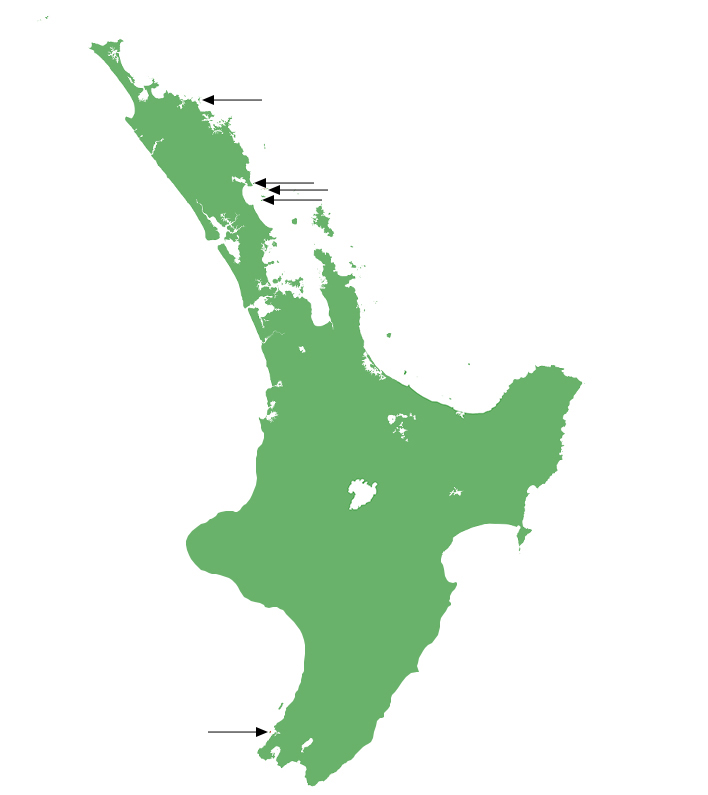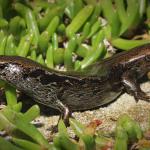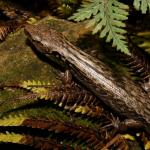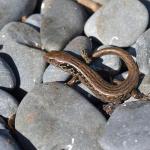- Home
- Herpetofauna Index
- Native
- Oligosoma Macgregori
Oligosoma macgregori
McGregor's skink
Oligosoma macgregori
(Robb, 1975)
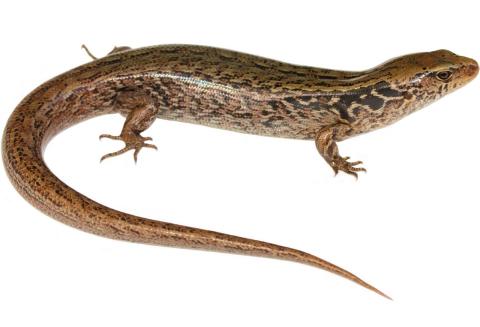
Length: SVL up to 119mm, with the tail being equal to or longer than the body length
Weight: up to 48 grams.
Description
McGregor's skinks are a distinctively patterned, large and robust species. They are well-known for their temperament, and will often bite fiercely when handled.
They are characterised by their light to dark brown dorsal (upper) surfaces, which are either uniform or have flecking/long streaks (either paler or darker than the base colour). Their flanks (sides) are for the most part grey-brown with irregular black markings and numerous pale streaks or blotches (often with dark edging). The area around the neck and forelimbs is particularly distinctive with the irregular black markings being much larger in that region. Their ventral (lower) surface is yellow to pink, being either uniform or covered with dark flecks; their throat is cream-coloured and may have flecking. This species has a pale, black-edged teardrop under each eye.
Life expectancy
Ages of over ten years recorded for wild animals. Captive animals have been reported to live 55+ years (D. Keall, personal communication, May 22, 2021).
Distribution
Originally found throughout the majority of the North Island, McGregor’s skinks are now restricted to a fraction of their former range. They now only occur on a few pest-free islands scattered between Northland and Wellington; four remnant populations exist (Mana Island, Sail Rock, Bream and Cavalli Islands), and two translocated populations (Lady Alice and Whatupuke Islands).
Ecology and habitat
McGregor's skinks are a large crepuscular or nocturnal species. They are particularly susceptible to evaporative water loss through their skin, so utilise humid and thermally stable microhabitats.
They occupy a range of coastal habitats including open rocky platforms among dense vegetation such as flax (Phormium spp.), and New Zealand iceplant (Disphyma australe). They also inhabit coastal forest and scrub where they take refuge among thick leaf litter, under rocks and logs, or in seabird burrows during the day.
Social structure
McGregor's skinks are solitary and aggressively territorial. They have been recorded attacking and killing other lizards (including their own species) when caught in pitfall traps.
Breeding biology
McGregor’s skinks are ovoviviparous, giving birth to litters of up to seven in late summer to early autumn (D. Keall, personal communication, May 22, 2021). As is the case with many lizard species, mating in Oligosoma may seem rather violent with the male repeatedly biting the female around the neck and head area.
Diet
McGregor’s skinks are omnivores. They are primarily insectivorous, but also prey on smaller species of lizards such as moko skinks (Oligosoma moco), and possibly consume carrion or regurgitated fish where they occur near seabird colonies. As with other native skinks, they likely forage for fruit and berries from native plants.
Disease
The diseases and parasites of Aotearoa's reptile fauna have been left largely undocumented, and as such, it is hard to give a precise determination of the full spectrum of these for many species.
The McGregor's skink, as with other Oligosoma species, is a likely host for at least one species of endoparasitic nematode in the Skrjabinodon genus (Skrjabinodon trimorphi), as well as at least one strain of Salmonella. In addition to this, it is thought to be a host for at least one species of ectoparasitic mite- most likely within the Ophionyssus genus.
Conservation strategy
DOC classify this species as 'At Risk - Recovering' (Hitchmough et al. 2021), due to the expansion of translocated populations, and their recovery on Mana Island following the eradication of mice.
McGregor’s skinks have been heavily impacted by the introduction of mammalian predators and are now one of our rarest species. They currently occupy less than 1% of their former range, and only occur on pest-free islands as they cannot coexist with introduced predatory mammals such as rats and mice.
McGregor’s skinks have been translocated from Sail Rock to establish two new populations on pest-free islands: Lady Alice and Whatupuke Island in the Marotere / Hen and Chicken group.
Interesting notes
Named in honour of Professor William Roy McGregor former head of the Zoology Department at the University of Auckland.
Genetic studies have shown that there is little divergence in populations of McGregor's skinks on Sail Rock (north of Auckland) and Mana Island (near Wellington), suggesting that there was substantial gene flow between these populations prior to the species decline.
The McGregor's skink sits within clade 4 (the teardrop skink complex) of the Oligosoma genus, being sister to all of the ornate skink complex (e.g. marbled, Whitaker's, ornate skink etc.). The Falla's skink and robust skink are also members of this clade but diverged much earlier.
References
Gill, B.J., & Whitaker, A.H. (2007). New Zealand frogs and reptiles. Auckland: David Bateman Limited.
Hitchmough, R.A., Barr, B., Lettink, M., Monks, J., Reardon, J., Tocher, M., van Winkel, D., Rolfe, J. (2016). Conservation status of New Zealand reptiles, 2015; New Zealand threat classification series 17. Wellington: New Zealand Department of Conservation
Jewell, T. (2011). A photographic guide to reptiles and amphibians of New Zealand. Auckland: New Holland Publishing Ltd.
van Winkel, D., Baling, M. & Hitchmough, R. (2018). Reptiles and Amphibians of New Zealand: A field guide. Auckland: Auckland University Press, 376 pp.

